

Metal detecting holidays in England with the World's most successful metal detecting club.
Twinned with Midwest Historical Research Society USA
|
March
2006 Finds
|
|||
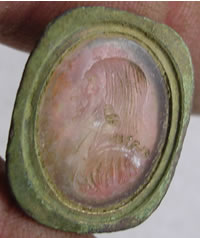 |
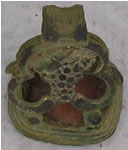 |
||
|
Georgian
fob seal
|
|||
 |
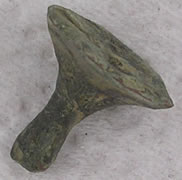 |
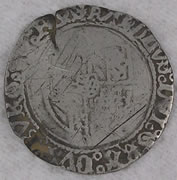 |
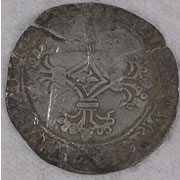 |
|
Fascinating
13thC seal matrix that appears to have a man and a woman people facing
each other with a heart in the middle
|
1475 Dutch
-Karel de Stoute -silver DOUBLE STUIVER
|
||
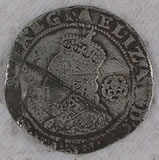 |
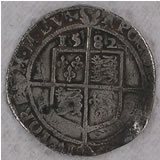 |
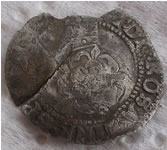 |
|
|
1582
Elizabeth 1st hammered
silver sixpence
|
1605
James 1st half groat ( 2 pence)
|
||
 |
 |
 |
|
|
Georgian
watch winders
|
18thC
Dutch lead bale seal with Lion and crest design
|
Medieval
mount with animalface
|
|
 |
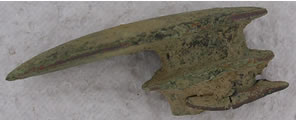 |
||
|
18thC
bayonet frog
|
Very
unusual 18thC bayonet frog design
|
||
 |
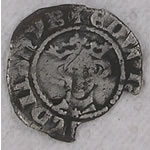 |
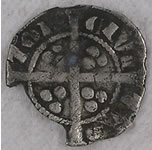 |
|
|
Silver
decanter decoration Post 1740
|
Edward
1st hammered silver penny- class 7a Canterbury mint
|
||
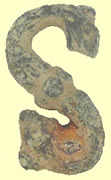 |
 |
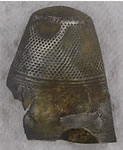 |
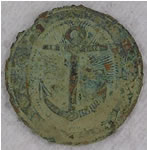 |
|
Celtic
serpent brooch
|
Possible
Roman silver ring fragment with emperors bust
|
18thC
silver decorated thimble
|
Pre
1840 Navy button
|
 |
 |
 |
 |
|
Saxon
period hanger - skull and crossed arms
|
Geometric
button
|
Interesting
animal head design watch winder
|
|
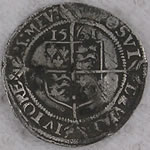 |
 |
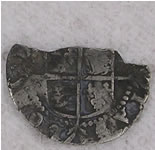 |
 |
|
1561 Elizabeth
1st hammered silver threepence 19.62 mm smaller flan type
|
1500's Elizabeth
1st hammered silver groat fragment
|
||
 |
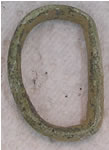 |
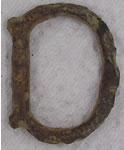 |
 |
|
Georgian
spoon
|
Post Medieval
buckle
|
Medieval
buckle
|
16thC German
jetton
|
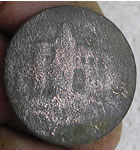 |
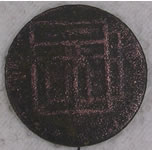 |
 |
 |
|
18thC Colchester
half penny
|
1834 William
IIII milled silver sixpence
|
||
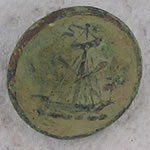 |
 |
 |
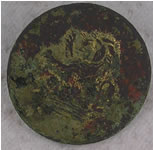 |
|
Ship button
|
Early medieval
skull mount
|
17thC hammered
copper trade farthing
|
Livery button
|
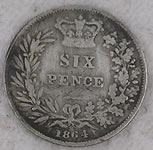 |
 |
 |
 |
|
1864 Victorian
milled silver sixpence
|
Early coin
weight possibly Roman WR
|
15thC lead
token - petal type
|
|
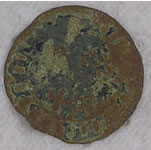 |
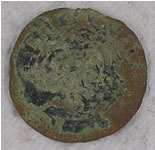 |
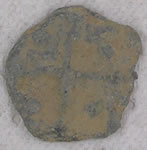 |
 |
|
17thC Jetton
|
15thC lead
token - long cross and pellet type
|
Percussion
cap
|
|
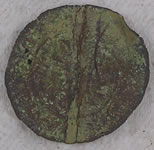 |
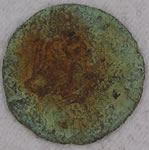 |
 |
|
|
17thC Jetton
|
18thC Silver
spoon with only half of the hallmarks showing
|
||
 |
 |
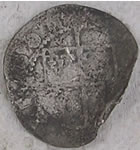 |
|
|
Edwardian
tea strainer
|
Coin weight
- not researched it yet
|
16thC Elizabeth
1st hammered silver penny
|
|
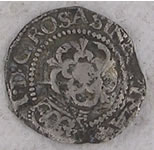 |
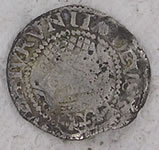 |
 |
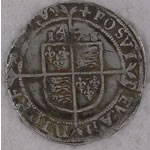 |
|
1618 James
1st hammered silver penny
|
1578 Elizabeth
1st hammered silver sixpence
|
||
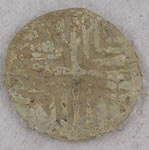 |
  |
 |
|
|
Medieval
lead weight
|
1st C Roman
fibula brooch - Colchester type
|
17thC sword
hanger fragment
|
|
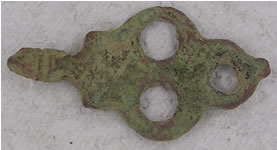 |
 |
 |
|
|
Roman key
fragment
|
Post Medieval
lead token
|
||
 |
 |
 |
|
|
17thC clothing
fastener
|
Georgian
pastry edger
|
16thC cotal
bell maker AG
|
|
 |
 |
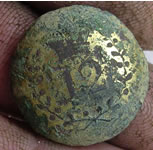 |
 |
|
17thC bronze
cup type bullion weight
|
Medieval
bronze pot leg
|
One peice
12th Regiment of foot officers button
|
Decorated
belt guide
|
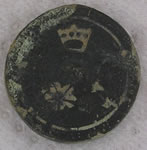 |
 |
 |
 |
|
Interesting
bronze trade weight - possibly Dutch
|
15thC lead
token
|
Roman cart
fitting
|
Fragement
of a Roman knife handle
|
 |
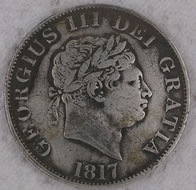  |
||
|
Post Medieval
belt mount
|
1817 George
III 'bullhead milled silver half crown ( 30 pence)
|
||
 |
 |
 |
|
|
1864 Victorian
milled silver sixpence
|
Post medieval
spur buckle
|
||
 |
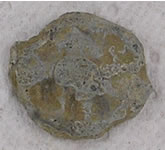 |
 |
 |
|
1770's -
21 shillings (Guinea) coin weight
|
Medieval
lead coin weight - cross design
|
Lead weight
- circle design possibly Roman
|
Post medieval
mount - heart shaped
|
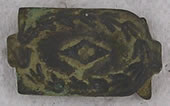 |
 |
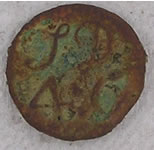 |
 |
|
18thC clog
fastener
|
1778 Russian
bale seal
|
1770's 4
shillings and 6 pence coin weight - written 4s6d
|
Georgian
metal chess piece
|
 |
 |
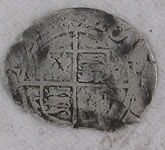 |
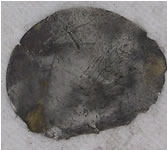 |
|
16thC Elizabeth
1st hammered silver fragment
|
16thC Elizabeth
1st hammered silver fragment
|
||
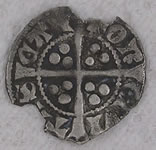 |
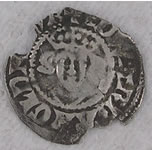 |
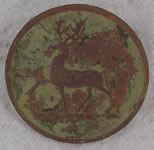 |
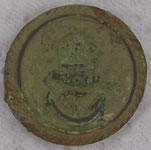 |
|
1327 AD Edward
III penny Canterbury mint
|
Stag livery
button
|
Post 1840
Navy button
|
|
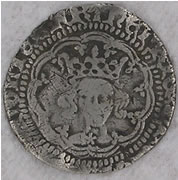 |
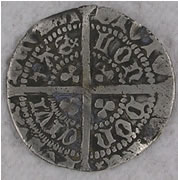 |
||
|
Very rare
Henry IV 1399 - 1412 Heavy coinage Type F London mint hammered silver
half groat
|
|||
 |
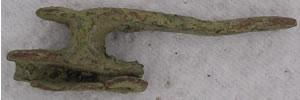 |
 |
|
|
18thC pastry
jigger
|
18thC Bayonet
frog
|
Late Medieval
mount
|
|
 |
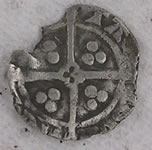 |
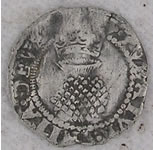 |
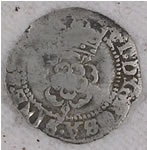 |
|
Edward III
Treaty period 1361-1369 probably York mint - quatrefoil - with - pellet
on reverse cross
|
1618 James
1st hammered silver half groat ( 2 pence)
|
||
 |
 |
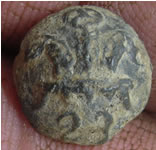 |
 |
|
1625 Charles
1st hammered copper rose farthing
|
23rd Regiment
of foot one piece button
|
2nd Regiment
of foot TM ?
|
|
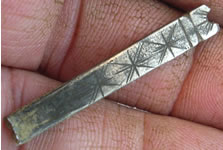 |
 |
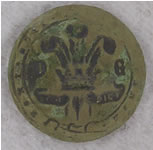 |
|
|
Interesting
hand decorated silver fragment
|
Silver love
token with initials and heart inscription
|
Dragoon Guards
button
|
|
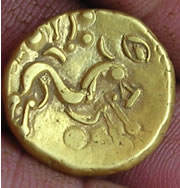 |
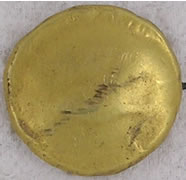 |
||
|
50BC Gallo Belgic Celtic gold stater 6.24g - 16.58mm found by Ark Jack 'This'll
be CCI 06.0190. Difficult to say exactly which class of uniface stater
it is with this amount of wear - indeed it's quite unusual to see one
which is this worn, it looks as though it knocked about a bit before
being lost/deposited'. |
|||
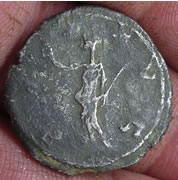 |
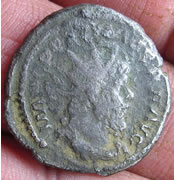 |
||
| 'That's
an antoninianus of Postumus - emperor of the Gallic Empire of Rome. The
northern and western provinces split off on their own during the difficult
and chaotic times in the 250's & 260's A.D. About the same time Valerian
was being captured by the Persians - and subjected to various colorful humiliations
- leaving his son Gallienus in sole charge of the empire, Postumus, who
had been one of Gallienus' generals, was proclaimed emperor by his troops
and found himself in a very favorable position of power. He therefore was
the emperor of Spain, Gaul and Britain for almost a decade. His successors
did not fare as well, and the Tetrici were eventually forced to abdicate
in favor of Aurelian. Interestingly, the Gallic Empire seemed to be wealthier than the empire at Rome, the quality of the Gallic coins is higher, as is their general level of silver - Postumus and successors managed to coin better silver, then billon, than did Gallienus under whose reign the antoninianus fell from an approximately 50% silver coin to a tiny, miserable, silvery-washed copper piece - some of the worst may not even have been silver-washed. Your piece is the PAX AVG type and shows Pax standing left, holding an olive-branch and scepter. With obverse legend IMP C POSTVMVS PF AVG it could be either mint of Lugdunum or Cologne, according to RIC, but there are many authorities who question the attributions to one or the other mint (assigning them on the basis of style) - it's probably best to say that the origin of most of the Gallic coins is unclear at best'. Mark |
|||
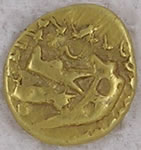 |
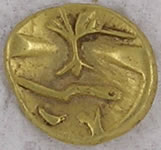 |
||
|
Celtic quarter Morini boat tree 70 BC found by Dakota Dennis CCI 06.0187 1.45g, 11.61mm 'The G-B quarter is a lovely coin, looks very sharp. There is a distinctive class of these which have all the little crosses around the 'boat' - they're not uncommon, but not always as nice as this'. |
|||
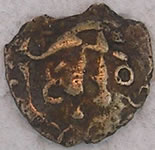 |
 |
||
|
50BC Trinovantes
Celtic gold (Clacton type)1/4 stater - 1.13g, 13.71g CCI 06.0188 found
by Dakota Lowell
|
|||
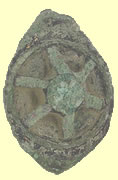 |
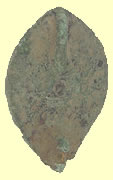 |
 |
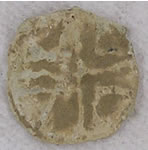 |
|
2ndC Roman
bronze disc brooch with gilding and enamel work
|
Solid gold
Georgisn watch winder
|
15thC lead
token
|
|
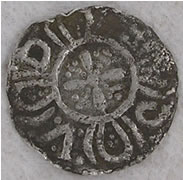 |
 |
||
|
King Offa
- 780 - 792 King of Mercia hammered silver .0.92g - 16.64mm
|
|||
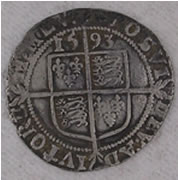 |
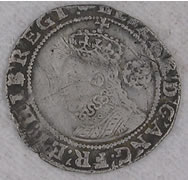 |
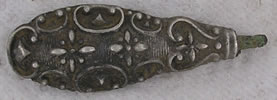 |
|
|
1593
Elizabeth 1st hammered
silver sixpence
|
Silver handle
2.07g, 34.38mm L- reported to museum as potential treasure - Id'd as 18thC
not treasure
|
||
 |
 |
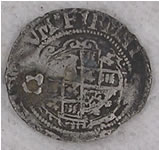 |
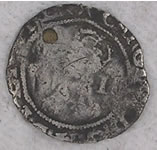 |
|
??
|
1641 Tower
mint - Charles 1st hammered silver half groat ( 2pence)
|
||
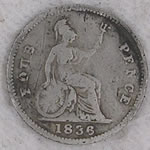 |
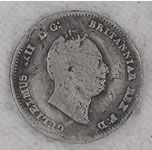 |
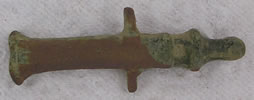 |
|
|
1836 William
IIII milled silver four pence
|
18thC working
toy cannon
|
||
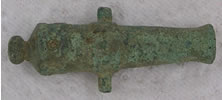 |
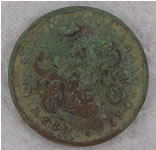 |
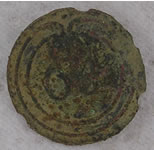 |
|
|
18thC working
toy cannon
|
Ipswich corporation
button
|
64th Regiment
French button
|
|
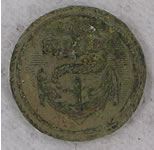 |
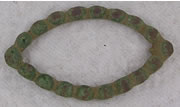 |
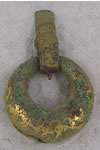 |
 |
|
Pre 1840
Navy button
|
Ornate Georgian
buckle
|
Heart
attack find - gilded hollow ring - no great age
|
Medieval
buckle fragment
|
 |
 |
 |
 |
|
Flying duck
button
|
1696
William III milled silver love token
|
Georgian
garter buckle
|
|
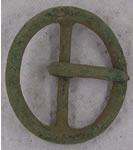 |
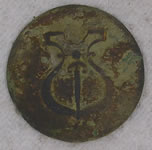 |
 |
 |
|
Annular buckle
1350 to 1650
|
18thC
button
|
1696
William III milled silver love token
|
Medieval
bromze pot pot
|
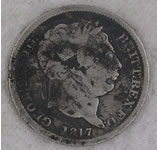 |
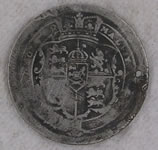 |
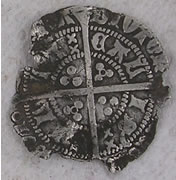 |
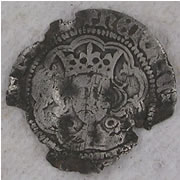 |
|
1817
George III milled silver sixpence
|
Henry
VI 1422-7 Annulet issue - Calais mint hammered silver half groat
|
||
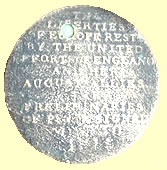 |
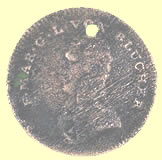 |
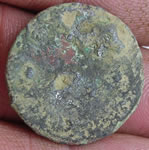 |
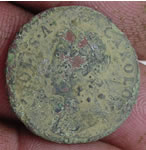 |
|
1815 Gebhard Leberecht von Blücher (1742-1819), Prussian Field Marshal The Battle of Waterloo, 1815 commemorative coin - great find |
Amazing
condition 1652 Charles II copper penny
|
||
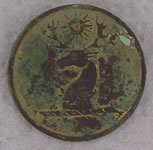 |
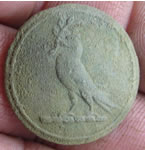 |
 |
 |
|
Stags
head livery button
|
Livery
button
|
Post
1740 silver button
|
Post
medieval bronze ring
|
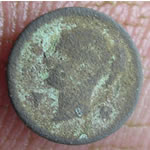 |
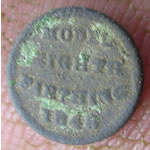 |
 |
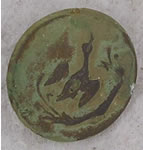 |
|
Smallest
coin ever found here 'Model Eight farthing' 1848 ??? 0.29g, 8.4mm
|
Christ
|
Bird button
|
|
 |
 |
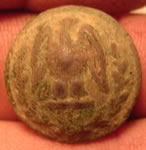 |
 |
|
Huge Roman Sestertius 19.11g, 31.1 mm 'A
little tough to be sure from the images, but I believe that's Faustina
II, the wife of Marcus Aurelius. If you rotate the obverse image 90
degrees clockwise, you see the characteristic hair-bun at the back of
her neck. also, what's visible of the legend is probably: FA [VST] INA
AVGVS [TA]. I can't really tell who the personification on the reverse
might be. She was married to M. Aurelius in 145 A.D. and died in 175
A.D., So if this isn't a "DIVA" posthmous type, and it doesn't
seem to be the sort struck under Antoninus Pius, this would date to
161-175 A.D. |
Military
button - which country ?
|
Georgian
watch winder with black star engraved stone ?
|
|
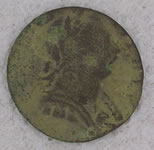 |
 |
 |
 |
|
George III
copper farthing in great shape
|
1700's 1/4
milled Spanish Reale silver coin
|
16thC decorated
crotal bell with markers mark '2'
|
|
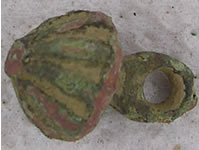 |
 |
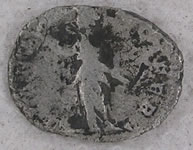 |
|
|
Superb Tudor
period decorated 16thC button with a style not seen before here
|
That's
Julia Domna, the wife of Septimius Severus and mother of Caracalla and
Geta. The denarius reads IVLIA AVGVSTA on the obverse and DIANA LVCIFERA
on the reverse which shows Diana standing left, crescent moon on her shoulders,
holding a long torch diagonally with both hands. This is a product of
the mint at Rome c. 196 A.D. - during the reign of her husband. RIC IV,
I 548, RSC 27, SR ('88) 1835, VM 15. Although RIC rates it "scarce",
I don't believe it's really any scarcer than most other relatively common
types.
Nice find! Mark |
||
 |
 |
 |
 |
|
1815 German
1 pfennig
|
Interesting
French Indochinese copper coin
|
||
 |
 |
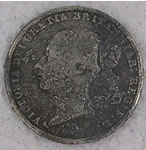 |
 |
|
1570 Elizabeth
1st hammered silver groat
|
1844
Victorian milled silver sixpence
|
Rolled over
hammered silver coin in rough shape
|
|
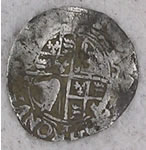 |
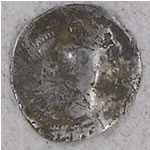 |
 |
 |
|
1625 Charles
1st hammered silver penny
|
1946 George
V milled silver sixpence
|
||
 |
 |
 |
 |
|
Early 18thC
harness mount
|
19thC lead
bale seal
|
WWII Iron
cross
|
17thC lead
token with heart design
|
 |
 |
 |
|
|
1791 Russian
lead bale seal
|
Copper
alloy buckle 18thC
|
||
 |
 |
 |
|
|
Medieval
gilded decorated clasp - hinged possibly from a bible or small chest
|
|||
 |
 |
 |
|
|
Cast copper alloy double loop oval buckle c1500 -1650 |
20thC silver
button
|
Post medieval
belt mount
|
|
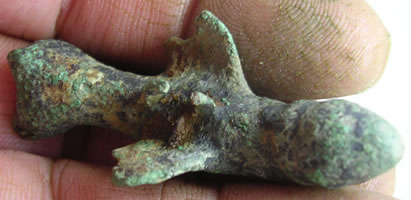 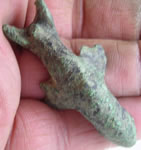 |
|||
|
Roman bronze
winged Phallus pendant 27.87 - 49.02mm L found by Cal Jeff
|
|||
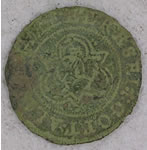 |
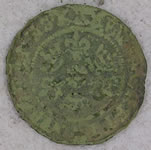 |
 |
 |
|
Hans Krauwinckel
c1560- 1610
German Jetton
|
Parys Mine
company 18thC token with a druid head. This was the face that launched
a collecting mania and thousands of manufacturers, merchants and shopkeepers
followed the lead.
|
||
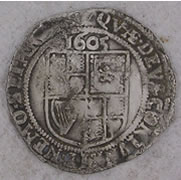 |
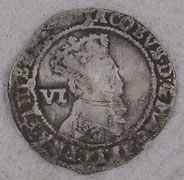 |
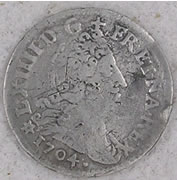 |
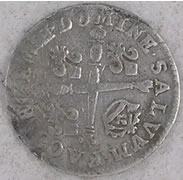 |
|
James 1st
hammered silver sixpence
|
1704 Louis
XIIII milled silver
|
||
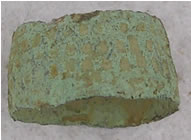 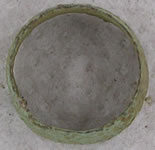 |
 |
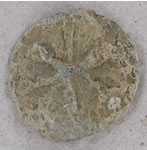 |
|
|
15thC open
top thimble
|
15thC lead
token
|
15thC lead
token
|
|
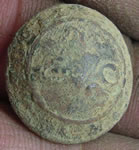 |
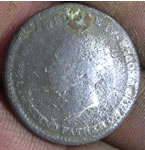 |
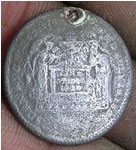 |
 |
|
Early one
piece 30th Regiment of foot button
|
George IIII
memorial medal
|
Huge crotal
bell - maker William Carr c1680
|
|
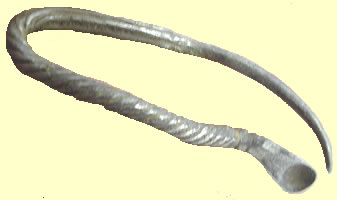 |
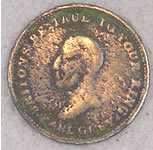 |
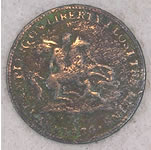 |
|
|
Roman silver
twisted ear wax scraper reported to museum as treasure
|
Britain be true to your King Trampling on Liberty lost the King 1830 |
||
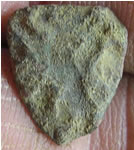 |
 |
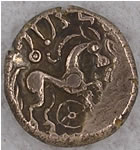 |
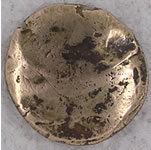 |
|
Medieval
heraldic shield mount
|
1830 Chinese
coin
|
North Thames type Celtic gold stater 5.54g - 16.93 found by Cal Mark 'many thanks for this one, a rare one indeed. It's an example of VA 1509, also in the BM catalogue (BMC 350) and no. 34 in 'Coins of England'. It usually has a couple of S shapes on the obverse, although I can't see any traces of them here - the obverse is sometimes worn though. It seems to be a North Thames type, to judge from the few provenances available, but there are only six examples previously recorded so it is a rare type. I would guess quite early too, perhaps 40s BC. Certainly one of the best Celtic you've had so far, thanks! It'll be CCI 06.0195'. |
|
 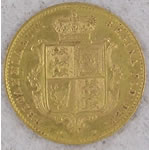 |
 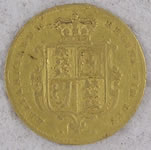 |
||
|
1867 Victorian
gold half Sovereign
|
1842 Victorian
gold half Sovereign
|
||
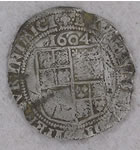 |
 |
 |
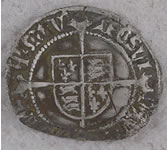 |
|
1604 James
1st sixpence
|
1508 Henry
VII hammered silver half groat - York Archb Bainbridge
|
||
 |
 |
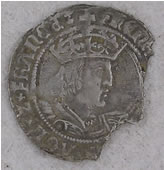 |
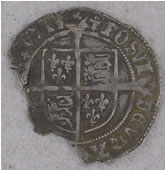 |
|
1526- 44
Henry VIII 2nd Profile issue - London Mint Obverse shows reversed Roman
D for C in HENRIC and in FRANC- Laker D hammered silver groat
|
1526- 44
Henry VIII 2nd coinage Laker E hammered silver groat
|
||
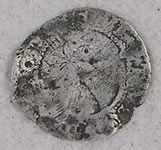 |
 |
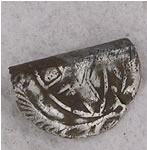 |
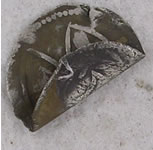 |
|
1570 Elizabeth
1st hammered silver half groat
|
1649
Commonwealth hammered silver half groat
|
||
 |
 |
 |
 |
|
1216AD
Henry III cut half voided long cross hammered silver ( can't clean, huge
stress crack )
|
1199
AD King John hammered silver half penny
|
17thC
bell clapper
|
|
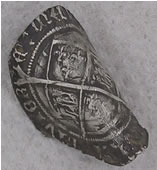 |
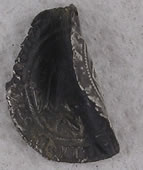 |
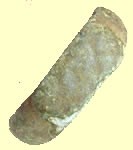 |
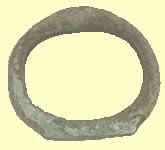 |
|
1509
Henry VIII hammered silver groat needs straightening to ID type
|
Roman bronze signet ring with initials XIX ROMAN LEGIONARY RING OF THE XIX LEGION (ONE OF THE LEGIONS OF THE VARUS DISASTER) |
||
 |
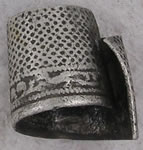 |
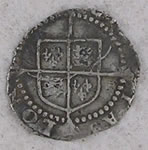 |
 |
|
17thC
decorated silver thimble reported as treasure - inscribed BB maker W
|
16thC
Elizabeth 1st hammered
silver penny
|
||
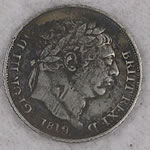 |
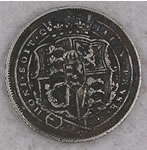 |
 |
 |
|
1819
George III milled silver sixpence
|
Solid
gold Georgian watch winder
|
Pre
1840 Navy button
|
|
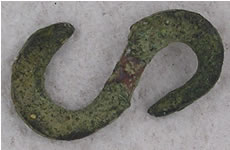 |
 |
||
|
Tudor
period snake clasp
|
18thC
toy cannon
|
||
 |
 |
 |
 |
|
18thC silver
medallion
|
Huge decorated
Copper alloy signet ring - needs careful cleaning - don't get a feel of
the date yet
|
1696 William
III over stamped love token
|
|
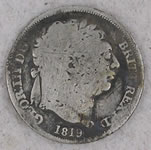 |
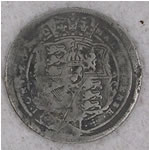 |
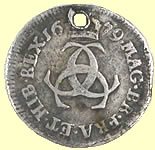 |
 |
|
1819
George III milled silver sixpence
|
1679
Charles II milled 3 pence
|
||
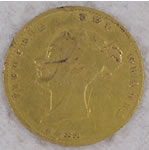 |
 |
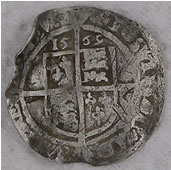 |
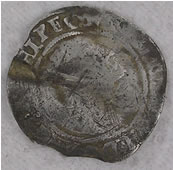 |
|
1842 Victorian
gold half Sovereign found by Boston Beau
|
1569 Elizabeth
1st hammered silver sixpence - 24.10mm
|
||
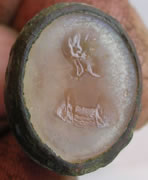 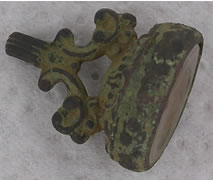 |
|||
|
Georgian
fob seal with woman in relief looking right
|
|||
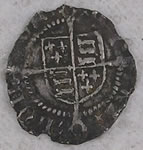 |
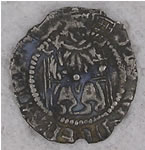 |
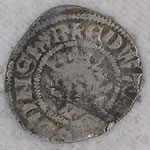 |
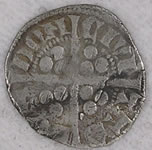 |
|
1509 - 26
Henry VIII first coinage 'Sovereign type' hammered silver penny
|
1307 Edward
II Medieval penny class 11C London mint- back from the straighteners
|
||
 |
 |
 |
 |
|
Excellent
35th Regiment of foot officers button - one peice
|
1696 William
III milled silver love token
|
1816
George III milled silver sixpence
|
|
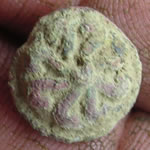 |
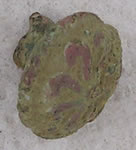 |
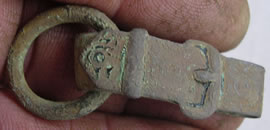 |
|
|
Very
unusual Tudor period c1500's button
|
Neat
Post medieval buckle
|
||
 |
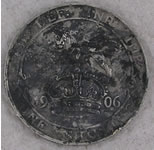 |
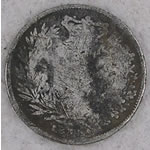 |
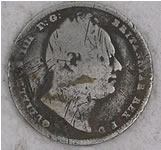 |
|
1906 Edward
VII milled silver sixpence
|
1834 William
IIII milled silver sixpence
|
||
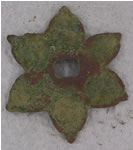 |
 |
 |
|
|
17thC knife
handle guard
|
17thC decorated
spoon bowl
|
London Veteren
Reserve badge
|
|
   |
|||
|
Celtic Woad
cosmetic grinder - boat shaped with suspension loop 14.5g - 45.12mm L
x 9.88mm T found by Mass Linda
|
|||
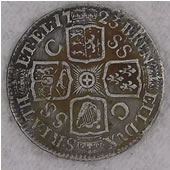 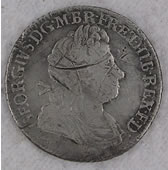 |
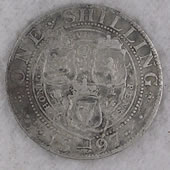  |
||
|
1723 George
1st SSC milled silver shilling - quite a rare find
|
Late Victorian
1897 milled silver shilling
|
||
 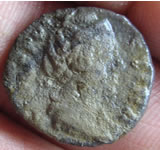   |
|||
|
What looked like a Roman debased silver - 3.16g 16.82mm ID That's
a denarius of Faustina I, wife of Antoninus Pius whom she married during
Hadrian's time. She died in 141 A.D. after giving birth to numerous
children, including the future Faustina II, wife of Marcus Aurelius. Mark Lehman |
|||
 |
 |
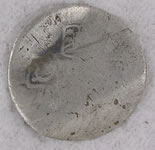 |
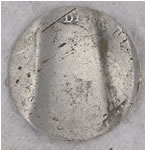 |
|
Victorian
1849 milled silver groat (4 pence)
|
1696 William
III milled silver sixpence lovetoken
|
||
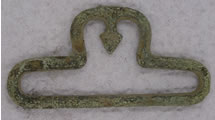 |
 |
 |
|
|
Unusual
belt slide probably 18thC
|
Medieval
buckle
|
19thC
buckle
|
|
 |
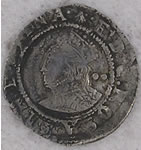  |
||
|
18thC Jews
harp
|
1560-1
Elizabeth 1st hammered silver half groat - Martlet Mintmark
|
||
  |
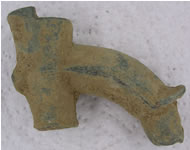 |
||
|
1356-
61 Edward III hammered silver half groat - Canterbury mint
|
17th/18th
C spout
|
||
  |
  |
||
| That
one's easy - that's a Constantinopolis city-commemorative. When Constantine
the Great moved his capitol from Rome to his newly-rebuilt city of Constantinople,
there was a large series of parallel "Urbs Roma" (to help appease
"jilted" Romans) and "Constantinopolis" coins issued
from all mints. Originally issued around 330 in great quantities, then declining
in size and numbers, they were revived after Constantine's death in 337
when the succession was somewhat in doubt - so that individual mints didn't
have to declare for the various contenders. As small as your is, it probably
dates to just before or sometime in the decade after Constantine's death. Your coin shows the allegorical personification of the city of Constantinople on the obverse, helmeted and with spear over shoulder and had the legend made it onto the undersized flan, would have read CONSTANTINOPOLIS. The reverse, anepigraphic but for the exergual mint mark, shows Victory on prow of a ship left. In your specimen, Victory holds an unusually prominent palm-branch (I think) - usually, she holds a spear and leans on a shield. Mark |
What
I can tell you, despite the lack of detail, is that this is a dupondius
of Trajan, 98-117 A.D. Luckily, in the early 2nd century A.D. the Romans
were still doing high-quality, representational work and Trajan's profile
is unmistakeable. The denomination, "dupondius" (two asses) is
indicated by the spiky, radiate crown of Sol - by this time, any coin displaying
this sort of headgear can be assumed to be a double-denomination. particularly
since the "S" of the obligatory "S - C" (Senatus Consultio
- "by consent of the Senate" - an official and fondly held myth
that the Senate still had any say in matters like the small-change supply
at this point in the Imperium) virtually all imperial AE's carried seems
to be in the correct position this way. I still can't quite make out who
or what is being portrayed here, and since Trajan was around for quite a
while - nearly 20 years - there are literally hundreds of possible reverse
types for dupondii. A complete WAG might be Hilaritas, who is usually portrayed
holding a long palm branch. Mark |
||
  |
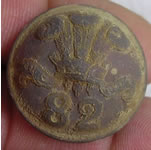 |
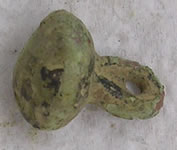 |
|
|
1817 George
III shilling
|
82nd Regiment
of foot
|
16thC Tudor
button
|
|
  |
  |
||
|
Post Medieval
bale seal with shield and cross design
|
1808 Louis
Napoleon, King of Holland - Netherlands East Indies 1/16th of a Guilder
|
||
  |
|||
|
Just cleaned
up an earlier ring find by Bud Bing to reveal the initial 'Pvke' - possibly
Roman from the area that produced the XIX legion ring
|
|||
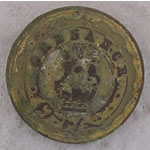 |
 |
 |
 |
|
Army Ordeance
?
|
Medieval
small chisel
|
Railway button
|
Georgian
decorated oval buckle
|
|
Interesting piece 26.39mm L inscribed 'IVI' on reverse - needs more investigation |
|||
 |
 |
 |
 |
|
Roman bronze
lynch pin
|
Roman bronze
pin head
|
37th Regiment
of foot
|
Medieval
apothecary scoop
|
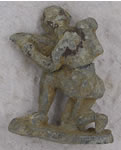 |
 |
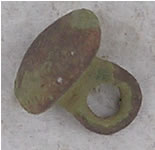 |
 |
|
20th C lead
soldier
|
2nd Regiment
of foot
|
16thC button
|
14thC gold
decorated ring brooch
|
  |
  |
||
| 'small-module follis of one of the members of the family of Constantine - and a perfect example of what I refer to as "Murphy's Law of Ancient Coin Legends" - the part that is most important, if there's any question who it is, will be the part that is missing. I can easily say who it isn't - it's neither Constans (wrong letter on the end) nor Constantius II (too early) - what I can read on the obverse is "...ONSTANTI.." but this could be either Constantine I or II. The reverse is the "SOLI INVICTO COMITI" type and shows radiate Sol standing left raising hand and holding a globe. It's from Lugdunum by the prominent "L" in the exergue (SLG, probably), and, looking in RIC, I see from the S - F fieldmarks that it's too early at 313-14 A.D.to be Constantine II.' | I
am not going to be able to tell you who or where-from on this one - but
your reverse image was upside-down again. It's a GLORIA EXERCITVS (Glory
of the Armies) with 2 soldiers, holding spears in outer hands and resting
inner hands on shields, flanking 2 legionary standards. The 2-standard type
are the earlier form with this legend and date to 330-335 or so. Again,
it's a member of the family of Constantine - could even be Constantine himself,
but there doesn't appear to be any usable legend on the obverse of this
one at all'. Mark |
||
 |
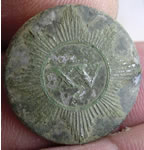 |
 |
|
|
1st
C BC/AD Roman La Tene fibula brooch
|
15th
Regiment of foot officers one piece button
|
C1000
BC Bronze Age socketed implement fragment 35.57 mm L x 21.99 mm W
|
|
  |
  |
||
|
This
time you have two unofficial coins. I've been trying to move away from
the term "barbarous" in describing these because it's an outmoded
and rather pejoritive term coined by elitists of an earlier age - as in
"Barbarous Radiate" - when, in reality, the folks who made and
used these coins were no more barbarous than those who made and used the
coins they imitate. But whether you use the term "Contemporary Counterfeit",
"Unofficial Imitative", "Ancient Forgery, or "Barbarous
Radiate", that's what the first one is. I can't tell from your photo
whether the radiate portrait is bearded or not, but the prototype for
this coin would most likely have been an official, Gallic Empire antoninianus
of Tetricus I or II - "Dad" being bearded, and "Junior",
clean-shaven. At this size and weight, adequate for even an official coin
of the era, it is unusual to see such crude and illiterate work - that
usually appears on the smaller ones which didn't try nearly so hard to
imitate the prototypes in general.
Whether these were counterfeits made to decieve (seems unlikely dunnit? what with this level of workmanship), filled a general need for coin in an era of chaos when official coin was unavailable, were the equivalent of "Plantation Tokens" - scrip used in large Latifundia - farming estates - and/or were meant to be exchangeable for regal coin when it became available again - well, we just don't know. They might have filled any of these functions, all of them, or "none of the above". At any rate, the prototype for this specimen, as far as I can tell, was the SPES AVG type common to all the Gallic Emperors. This shows Spes - allegorical personification of "Hope" - advancing left, holding a flower and hitching the hem of her skirt. If the bust proves to be beardless, you can say it was copied (loosely) from Tetricus II, if bearded, it could copy, in about this order, Tetricus I, Victorinus, Postumus, or - far less likely - Laelianus or Marius, both of whom were extremely short-lived. The second, broken one is also probably unofficial. It's a bit harder with the coins of the Severans to be certain. The prototype, if it's not actually official, is a denarius of Septimius Severus dating to about 211 A.D. The coin, were it whole, should read "SEVERVS PIVS AVG" on the obverse and "P M TR P XVIII COS III PP" and shows Jupiter standing left, holding thunderbolt and scepter, between two children (Caracalla and Geta, presumably) - RIC 233, RSC 539. This one is a bit more problematic to tell whether or not it's official. You say it's AE, right? The Severan denarii underwent significant debasement so that some issues of even irrefutably official specimens may appear to be billon or even AE after millennia in the ground. There also exists a significant body of high-quality copies in AE, some lightly silvered, which seem to be unofficial. Since these have been appearing in larger numbers in recent years since the use of metal detectors has become commonplace, particularly in Eastern Europe, they have been - probably wrongly - conflated with the "Limes Falsa" lightweight, crude AE's in imitation of the AE types of the 1st and earlier 2nd centuries A.D. found along the "Limes" or borders of the Empire. The name "Limes Denarius", although a misnomer, has been applied to these so often that it has stuck. Here again, although we know that these AE denarii are more or less faithful copies of silver prototypes, and we know that they were both struck and cast in various places - we even have numerous molds and forgers' dies - we don't understand the role, if any, they may have played in the official monetary system. Were they copies made by semi-Romanized folks just outside the reach of empire? - folks who had become accustomed to the use of coin but who did not have access to official supplies? Were they a form of military scrip meant to keep large quantities of precious metal from falling into enemy hands in the event of a defeat - and presumably redeemable in good coin at some future date? Were they out-and-out counterfeits? Were they particularly debased official issues? (well, the cast ones probably weren't) Or did they fill some, as-yet unknown function? They might have done any or all of these at various times and places. Or, your coin might just be lower-grade silver and completely official. Mark |
|||
   |
|||
|
Celtic bronze coins sent to CCI for recording Right facing horse Addedomaros style 45 BC - Left facing horse like a Cunoblein 'Biga' type Early 1stC |
|||
 |
 |
||
|
Post Medieval
small chisels/implements
|
16thC Tudor
button
|
||
  |
  |
||
|
1865 - 3
Pfenninge German states Prussian coin
|
1836 William
IIII milled silver 4 pence
|
||
 |
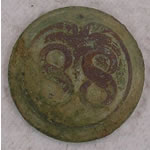 |
 |
|
|
19thC Knife
Scabbard tip
|
88th Regiment
of foot
|
18thC gilded
decorated clog fastener
|
|
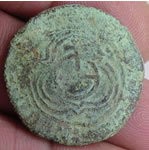 |
  |
||
|
16th/17th
C German Jetton
|
A fragment
of a Romano-British protected loop terret. 28.5 mm L x 17.9 mm W
|
||
 |
 |
||
|
Complete
hasp and clasp - Georgian
|
17thC pewter
child's finger ring
|
||
 |
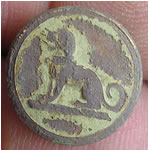 |
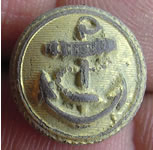 |
 |
|
Dress button
|
Livery button
|
Navy button
|
Georgian
cuff link
|

